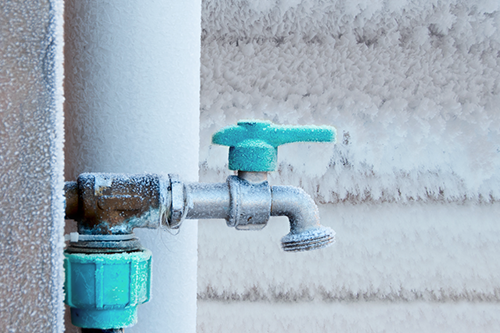Canadian winters are often bitterly cold and long. For landlords and rental property owners, winter can create all sorts of problems for you and your tenants, especially when the temperature plummets. That’s when the risk of water pipes freezing, cracking, and leading to water damage can occur.
When frigid temperatures cause water inside a pipe to freeze, the ice expands and can split or crack the water line. Should that happen, it will lead to leaks that cause water damage to a building or house. Worse than that, the pressure that builds up inside a frozen pipe can result in the pipe bursting and may lead to internal flooding.
No landlord wants to deal with a burst water pipe. After all, repairing burst pipes is expensive, and if the damage is significant, you could lose rental income if tenants are forced to relocate while repairs are underway. That’s why it’s worthwhile to purchase a landlord insurance policy.

Download Our FREE Insurance Guide
Learn everything you need to protect your small business.
Whitepaper download
"*" indicates required fields
Your email address will be used by Zensurance to provide latest news, offers and tips.
You can unsubscribe at any time.

Related Posts
Categories
Nevertheless, here’s what to do if you think your building has a frozen water pipe:
How to Locate a Frozen Pipe
There are a few ways to tell if you’ve got a frozen water pipe in your building, including:
- There’s no running water or only a trickle from faucets.
- Frost is visible on a pipe.
- Unpleasant odours are coming from faucets and drains.
- If your building has a water boiler and it isn’t working as it should, there’s a chance the pipe attached to the boiler may be frozen.
The most likely place to find a frozen water pipe is those located against an exterior wall and where the water intake service pipe enters the building through the foundation wall.
How to Thaw a Frozen Water Pipe
If you locate a frozen water pipe in your building, it’s recommended to contact a professional plumber to fix it. However, you can try to thaw frozen pipes by taking the following actions:
- Turn off the water supply first.
- Open a cold water faucet in the basement or laundry room.
- Apply heat to the frozen pipe by warming the air around it or applying heat directly to it with an electric heating pad, hair dryer, warm towel, or space heater. Don’t leave electrical heating elements unattended. DO NOT use open flame to thaw a frozen water pipe.
- Be patient. Thawing a frozen water pipe can take several hours.
- Once the pipe is thawed, turn on the water slowly and examine the line closely for leaks or cracks.
If a frozen water pipe is not accessible, you may have to wait for it to thaw on its own. We highly recommend you contact a plumber if you believe your building has a frozen water pipe.
9 Ways to Prevent Water Pipes From Freezing in the Winter
Here are nine steps to take to try to prevent water pipes in your building from freezing during the cold months:
1. Disconnect and drain outside garden hoses, close the shut-off valves that allow water to travel to an outdoor faucet, drain the line, and keep the outside tap open during the winter to prevent the pipe from cracking in case there’s water inside the line that may freeze and expand.
2. Consider hiring a plumber or contractor to insulate pipes in unheated areas to protect them from the cold.
3. Seal any cracks or holes around exterior water pipes and your building’s foundation to prevent cold air from getting through.
4. Keep a home’s garage doors closed, especially if exterior water supply lines are in the garage.
5. Opening kitchen and bathroom cabinet doors to allow warmer air to circulate around the plumbing can help prevent these pipes from cracking.
6. Keep the thermostat consistently set to the same temperature during the day and at night. Keeping the thermostat set to at least 18 degrees Celsius is recommended.
7. If your property is vacant, check it frequently to ensure there are no frozen pipes or leaks. You may also require vacant property insurance. This type of policy is for landlords whose properties are uninhabited or considered empty for an extended time.
8. Conduct inspections regularly to ensure no minor issues become major problems later. For instance, fix any drips or minor leaks immediately.
9. Know where to find the primary water shut-off value if a pipe bursts.
If you suspect you have a frozen pipe or spot cracks on an exposed pipe, turn off the building’s water supply and call a plumber.
How Landlord Insurance Can Protect Your Property and Tenants
A comprehensive landlord insurance policy from Zensurance can help you protect your property year-round.
Our knowledgeable brokers can get the low-cost coverage you need, answer your questions, and customize a policy to suit your requirements.
Start by filling out our online application for a free quote. Let our team protect your rental properties from the wide range of risks every landlord faces.
Recent Posts
Why November Is the Perfect Time for Bookkeepers to Review Their Insurance
As we inch toward the end of another year, bookkeepers are busy preparing for the end of their clients’ financial year. But now is the ideal time for bookkeepers to review and assess their insurance. We’ll give you 10 reasons why.
Is Your Salon Ready for the Holidays? Insurance Tips for Beauticians
Salon owners and independent beauticians need to stock up on the products they need to make their clients shine over the holidays. But ensuring they're adequately covered with customized insurance is also critical. Here's what to know.
10 Tips for Closing Your Small Business for the Winter
Are you closing up shop for the winter? Ensuring your property is prepared for winter and your valuable contents and inventory are safely stored is vital. See our tips for how small business owners can shut down operations and keep their assets safe.
Sign Up for ZenMail
"*" indicates required fields








